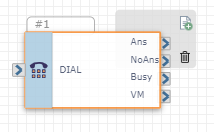Dial
The Dial action allows you to call a specified phone line.

The Dial action could be used:
-
Following an Inbound API trigger to play a voice notification after a change in an integrated system.
-
Following a Sentiment action to call an agent if negative feedback is received.
The functionality of the Dial action is very similar to the Transfer action, though there are a few subtle differences to keep in mind:
-
Transfer has transfer/whisper audio capability.
-
Dial initiates a new voice channel, but Transfer merges a new voice channel with the existing flow channel.
Available Variables
Available Variables are placeholders for information that are automatically determined based on the contents of your flow. For example, if your flow begins with an Inbound Call trigger, the caller's phone number is stored as a $ANI variable. Later on in your flow, you can send a follow up SMS to the caller by adding the $ANI variable in the Send SMS/MMS action Inputs.
Check out How to Use Variables in SmartFlows for more information.
Inputs
Advanced
Include advanced User to User Information (UUI) options as needed for your flow.
| Input Name | Description |
|---|---|
| UUI Encoding | Supported encoding methods for UUI header. |
| UUI Header | Add additional unique identifiers in the request when transferring a call. |
Action
Each Dial action includes four exit ports corresponding to the following call outcomes:
-
On Answer: The course of the flow if the call is answered (port 1)
-
No Answer: The course of the flow if the call is not answered by the time defined in the Timeout input, and the recipient has not set up their voicemail (port 2)
-
On User Busy: The course of the flow if the called number is busy (port 3)
-
On Voice Message: The course of the flow if the call reaches voicemail or is ignored (port 4)
Note: The VM Detection input must be checked in order to recognize that a voicemail box is present for the "On Voice Message" exit port.
An action must be connected to each of the four exit ports to deploy your flow and the port order cannot be rearranged.